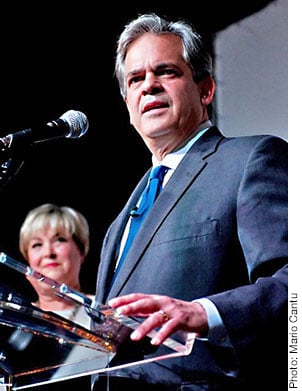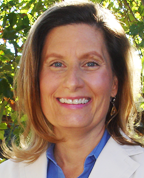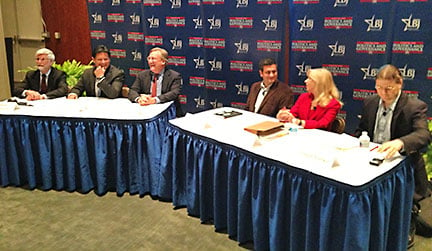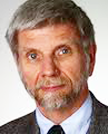Geographic Representation
An Election For History Books
An Election For History Books
Geographic representation achieved, GOP wins
three seats, and several other records set
by Ken Martin
©The Austin Bulldog 2014
Posted Wednesday December 17, 2014 8:28pm
Updated Thursday December 18, 2014 6:21am
 The largest landslide margin ever in an Austin mayoral runoff was achieved last night, as mayoral victor Steve Adler swamped incumbent Council Member Mike Martinez.
The largest landslide margin ever in an Austin mayoral runoff was achieved last night, as mayoral victor Steve Adler swamped incumbent Council Member Mike Martinez.
In Travis and Williamson counties a combined total of 80,669 votes were cast in the mayor’s race. Adler garnered 54,366 for 67.39 percent, while Martinez netted 26,303 for 32.61 percent.
Laura Morrison set the previous record by getting 65.0 percent of the votes in her 2008 runoff against Cid Galindo. Robert Barnstone got 64.98 percent in beating Sam Guzman in a 1988 runoff.
Lee Cooke in 1988 set the prevous record for margin of victory in a mayoral runoff when he got 58.43 percent of the votes to unseat incumbent mayor Frank Cooksey.
 At age 25, Greg Casar became the youngest Austin City Council member ever elected.
At age 25, Greg Casar became the youngest Austin City Council member ever elected.
Previously the youngest council member was 26-year-old Jeff Friedman, elected in 1971.
Friedman’s campaign consultant in that election, Peck Young, verified this, saying, “Jeff was the youngest when he was elected and Greg beats him by a year.” Casar will turn 26 in early May.
Casar ran a smart campaign to soundly defeat now two-time loser Laura Pressley (she got an impressive 44.48 percent of the votes in her one-on-one challenge of incumbent Martinez in 2012).
 Casar’s District 4 victory of 2,851 votes (64.62 percent) to her 1,561 (35.38 percent) resulted in part from her campaign’s faux pas. Perhaps not the least of which was getting involved in a discussion of the 9-11 attacks being an inside job, which drew intense media coverage, and her latest mail piece attacking Casar for, among other things, allegedly being an atheist.
Casar’s District 4 victory of 2,851 votes (64.62 percent) to her 1,561 (35.38 percent) resulted in part from her campaign’s faux pas. Perhaps not the least of which was getting involved in a discussion of the 9-11 attacks being an inside job, which drew intense media coverage, and her latest mail piece attacking Casar for, among other things, allegedly being an atheist.
Still, last night Pressley couldn’t resist a parting shot. A little after 8pm as early voting results showed she was already behind by more than 700 votes, she insisted on being quoted as saying, “Greg sold District 4 to special interests.”
In response Casar told The Austin Bulldog, “My track record stands up for working people and progressive ideals, even when special interests stood in the way. I’m going to stay committed to that.”
Women rule
What Can Austin Learn From California?
What Can Austin Learn From California?
Panel discussion focuses on how Golden State
experiences inform city’s move to 10-1 council
by Ken Martin
© The Austin Bulldog 2013
Posted Monday, May 6, 2013 2:00am
Updated with video link Tuesday May 7, 2013 10:50am
 California’s official nickname, The Golden State, adopted in 1968, harkens back to the discovery of gold in 1848. Now the left-coast state’s experiences with using an independent citizens commission to draw maps for 177 seats in four different governing bodies offers a golden opportunity for learning how best to implement the City of Austin’s 10-1 plan.
California’s official nickname, The Golden State, adopted in 1968, harkens back to the discovery of gold in 1848. Now the left-coast state’s experiences with using an independent citizens commission to draw maps for 177 seats in four different governing bodies offers a golden opportunity for learning how best to implement the City of Austin’s 10-1 plan.
The 10-1 plan for electing council members from geographic districts was approved by 60 percent of Austin voters last November 6 who voted for Proposition 3. Work is well underway to establish an Independent Citizens Redistricting Commission (ICRC) that will draw council districts to be implemented in the November 2014 election. The ICRC’s duties are specified in Article II, Section 3 of the Austin City Charter.
Close to a hundred people attended the panel discussion held the evening of Thursday, May 2, at the Bass Lecture Hall on the University of Texas campus. Upwards of half of those raised their hands when asked who had applied to serve on the ICRC.
The event was jointly hosted by UT’s School of Law, the LBJ School’s Center for Politics and Governance, and Austinites for Geographic Representation.
Redistricting Veteran Shares His Wisdom
Redistricting Veteran Shares His Wisdom
Member of California Redistricting Commission
describes what to watch out for in Austin redistricting
by Ken Martin
© The Austin Bulldog 2013
Posted Thursday May 2, 2013 3:55pm
One of the 14 members of the California Redistricting Commission was the featured speaker at today’s luncheon hosted by Austinites for Geographic Representation and sponsored by the Austin Area Research Organization and League of Woman Voters Austin Area.
 Attorney Angelo Ancheta is director of the Katherine and George Alexander Community Law Center and an associate clinical professor at Santa Clara University, where he teaches on subjects including election law, voting rights, and immigration. He came to Austin at his own expense and with no other business here to help educate the community about what to expect going forward.
Attorney Angelo Ancheta is director of the Katherine and George Alexander Community Law Center and an associate clinical professor at Santa Clara University, where he teaches on subjects including election law, voting rights, and immigration. He came to Austin at his own expense and with no other business here to help educate the community about what to expect going forward.
From an applicants’ pool of 30,000 people, Ancheta won a slot on the California Redistricting Commission, the group that drew the maps for four different political jurisdictions, which included 80 seats in the California State Assembly, 40 seats in the California State Senate, 53 seats in the U.S. House of Representatives, and four seats on the California State Board of Equalization.
Ancheta’s experience in drawing maps for California, a state with 38 million people, offers good insights into what lies ahead for the City of Austin and its 845,000 people.
Proposition 3 Rally Draws 150-200 People
Crowd hears fiery speeches by proponents of
the 10-1 system for electing council members
by Ken Martin
© The Austin Bulldog 2012
Posted Monday, October 8, 2012 10:13am
The rain-delayed “Trust Austin” rally honoring civil rights leader Arthur DeWitty, originally scheduled for a week earlier, drew a Saturday audience that event organizers Austinites for Geographic Representation (AGR) estimated at 150-200 people to the Park Place Pavilion in East Austin.
It was the latest in a string of Proposition 3 campaign activities that included multiple in-house fundraisers and a garage sale, as well as numereous appearances at neighborhood association meetings. Funds raised so far have been used to print 100,000 door hangars, plus yard signs and fliers to be distributed by volunteers.
Representatives from numerous community organizations spoke in favor of the 10-1 plan, leaving no doubt of their passion for electing City Council members from geographic districts, instead of the all-at-large system that’s been in place since 1953.
 Noting that some form of geographic representation had been on the ballot six times before and failed, retired State Senator Gonzalo Barrientos said, “Politicians put it on the ballot and then sat on their hands. We want geographic representation.”
Noting that some form of geographic representation had been on the ballot six times before and failed, retired State Senator Gonzalo Barrientos said, “Politicians put it on the ballot and then sat on their hands. We want geographic representation.”
Barrientos said Mayor Lee Leffingwell and Mayor Pro Tem Sheryl Cole asked him to sit on the 2012 Charter Revision Committee, which he chaired. “Hundreds of people said what they wanted, and we recommended the 10-1 plan” to the City Council. “Did they pay attention? No!
Attorney Bickerstaff Addresses Critics’ Concerns
His September 24 article drew numerous comments about the
Proposition 3 Independent Citizens Redistricting Commission
by Steve Bickerstaff
Posted Friday, October 5, 2012, 3:30pm
Editor’s introduction: Proposition 3 is on the November 6 ballot. If it gains voter approval and garners more votes than Proposition 4, Proposition 3 would require 10 council members to be elected from geographic districts and the mayor to be elected at-large. Proposition 3 requires an Independent Citizens Redistricting Commission to draw council districts the City Council would have no choice but to adopt.
It is important that Austin voters have a thorough understanding of the Citizens Independent Redistricting Commission before casting ballots in this important election. To that end, on September 24, The Austin Bulldog published attorney Steve Bickerstaff’s scholarly study of the strengths and weaknesses of various systems used for redistricting throughout the nation, including 50 cities. (Bickerstaff’s extensive legal experience with redistricting was detailed in the introduction to that article and need not be repeated here.)
That article drew 20 comments, some of which needed a much fuller response than could be accommodated through posting replies in the comments section. Bickerstaff wrote this piece to address the concerns raised in those comments—specifically the points raised by Proposition 4 advocates Julio Gonzalez Altamirano and Richard Jung. Proposition 4 provides for electing eight council members from geographic districts and the mayor and two council members at-large. Districts would be drawn as determined by a later ordinance.
 Thank you for the opportunity to join the dialogue on the possibility that the voters of Austin will adopt an independent redistricting commission.
Thank you for the opportunity to join the dialogue on the possibility that the voters of Austin will adopt an independent redistricting commission.
I am not a member of Austinites for Geographic Representation (AGR). My clients in the past have utilized essentially every form of election system [e.g. single-member districts, at-large elections (Austin), and hybrid systems using a combination of at-large and single-member elections (Houston)]. Each of these election systems has advantages and disadvantages.
Feisty Debate Over How to Elect Council
One panelist argues for no change to the
at-large system for City Council elections
by Ken Martin
© The Austin Bulldog 2012
Posted Thursday, October 4, 2012 6:40pm
The University of Texas Law School provided the venue for a fourth public debate over the question of whether—or even if—the Austin City Charter should be amended to allow for some form of geographic representation on the Austin City Council.
 The September 28 debate was emceed by Sherri Greenberg, a former state representative who is director of UT’s Center for Politics and Governance at the LBJ School of Public Affairs.
The September 28 debate was emceed by Sherri Greenberg, a former state representative who is director of UT’s Center for Politics and Governance at the LBJ School of Public Affairs.
All five panelists were members of the 2012 Charter Revision Committee that voted by a narrow 8-7 majority to recommend that 10 council members be elected from geographic districts and only the mayor continue to be elected at-large, that is by all voters.
 Ken Rigsbee, an independent oil and energy professional, voted to recommend the 10-1 plan and explained why. “It looked to me like the Charter Revision Committee would have a tie vote, after six months of arguing and debating,” he said. “I voted for 10-1. That doesn’t mean I wanted it—I just wanted to stop the meetings.”
Ken Rigsbee, an independent oil and energy professional, voted to recommend the 10-1 plan and explained why. “It looked to me like the Charter Revision Committee would have a tie vote, after six months of arguing and debating,” he said. “I voted for 10-1. That doesn’t mean I wanted it—I just wanted to stop the meetings.”
Rigsbee said he told Mayor Lee Leffingwell, who nominated him to serve on the Charter Revision Committee, “I said, ‘Lee, what is it about ‘no’ you don’t understand?’
He was referring to the fact that the voters of Austin had six opportunities between 1973 and 2002 to adopt geographic representation and the majority had always voted no.
“Is it worth spending $2 million for 11 council members vice seven, to force political horse-trading between council members?” Rigsbee asked. “Is it really imperative we do that? My answer is no.” (The city’s assessment of fiscal impact for the four additional council members and their staffs under Propositions 3 or 4 calls for $888,350 for construction and build-out for the additional offices, and an additional ongoing annual cost of $1,396,000 a year.)
The other panelists all agree that the at-large system in use since 1953 must be changed, but disagree on how to do that.
Propositions 3 and 4 Proponents Rev Campaigns
Raising money, organizing troops, and pushing plans
for geographic representation on Austin City Council
by Ken Martin
© The Austin Bulldog 2012
Posted Friday, September 28, 2012 2:39pm
The proponents of Proposition 3—Austinites for Geographic Representation (AGR)—got a huge head start in a grassroots campaign to win voter approval for geographic representation on the Austin City Council. They started meeting in February last year, waged a successful petition drive to get on the ballot, and have built a broad coalition of supporters, including 29 organizations and numerous community leaders. (For a list of endorsements, click here.)
The advocates for Proposition 4—Austin Community for Change (AC4C)—are pushing a different plan for geographic representation. They are running from behind and hoping to raise enough money to convince voters they have the best plan. They have rapidly built a list of 19 community organizations supporting their plan as well as individual community supporters. (For a list of endorsements, click here.)
Both AGR and AC4C have websites loaded with information touting their respective plans but there's a striking visual difference.
The banner atop the AGR pages contains a montage of nine photos taken at various Austin events.
The AC4C page headers show a photo purchased from iStockphoto.com titled “Diverse group casually dressed people looking up.”
Redistricting Need Not Be a Quintessentially Political Process
Quintessentially Political Process
Independent redistricting commissions for U.S. states and cities
Posted Monday, October September 24, 2012 6:05pm
Editor's introduction: Over the past 36 years attorney Steve Bickerstaff, adjunct professor at the University Of Texas School Of Law, has represented more than 100 jurisdictions on redistricting matters, including during the redistricting process, or before the U.S. Department of Justice, or in state or federal courts. These jurisdictions include the State of Texas (in three different decades) and various local governments (cities, counties, school districts, community colleges and special districts) in Texas and elsewhere. The electoral systems of these jurisdictions have included wholly at-large, wholly single-member, and hybrid or mixed (partially at-large) election structures.
He is author of Lines in the Sand (2007), a book about the controversial 2003 congressional redistricting in Texas; co-author of International Election Principles (2009); and author of 25 law journal articles dealing primarily with election law and telecommunications regulation.
Bickerstaff wrote the initial draft for the nonpartisan Citizens Independent Redistricting Commission. The Commission is an integral part of Proposition 3, which was put on the ballot through a petition drive conducted by Austinites for Geographic Representation. Bickerstaff’s draft was based on the Voters First Act, which through initiative and referendum established a system of independent redistricting in the State of California.
It is important that Austin voters have a thorough understanding of the Citizens Independent Redistricting Commission before casting ballots in the November 6 election. To that end, The Austin Bulldog is publishing Bickerstaff’s scholarly study of the strengths and weaknesses of various systems used for redistricting throughout the nation.
 Much has been written about the use of redistricting commissions for redrawing state legislative and congressional district lines. Twenty- two states now have some form of commission. However, the nature, jurisdiction and importance of these commissions vary greatly. By contrast, virtually nothing has been written about the use of redistricting commissions at the local level of government. This is particularly surprising because virtually all large and middle-size U.S. cities use at least some election districts that must be redrawn every 10 years, and because most of these cities are home-rule jurisdictions that generally have broad legal authority to adopt their own process for drawing local election district boundaries.[1] A purpose of this article is to provide government officials, public interest activists, and attorneys with a means for assessing the value of a municipal redistricting commission and for designing such commission to take self-interest and bias out of a process in which they have no legitimate role.[2]
Much has been written about the use of redistricting commissions for redrawing state legislative and congressional district lines. Twenty- two states now have some form of commission. However, the nature, jurisdiction and importance of these commissions vary greatly. By contrast, virtually nothing has been written about the use of redistricting commissions at the local level of government. This is particularly surprising because virtually all large and middle-size U.S. cities use at least some election districts that must be redrawn every 10 years, and because most of these cities are home-rule jurisdictions that generally have broad legal authority to adopt their own process for drawing local election district boundaries.[1] A purpose of this article is to provide government officials, public interest activists, and attorneys with a means for assessing the value of a municipal redistricting commission and for designing such commission to take self-interest and bias out of a process in which they have no legitimate role.[2]







